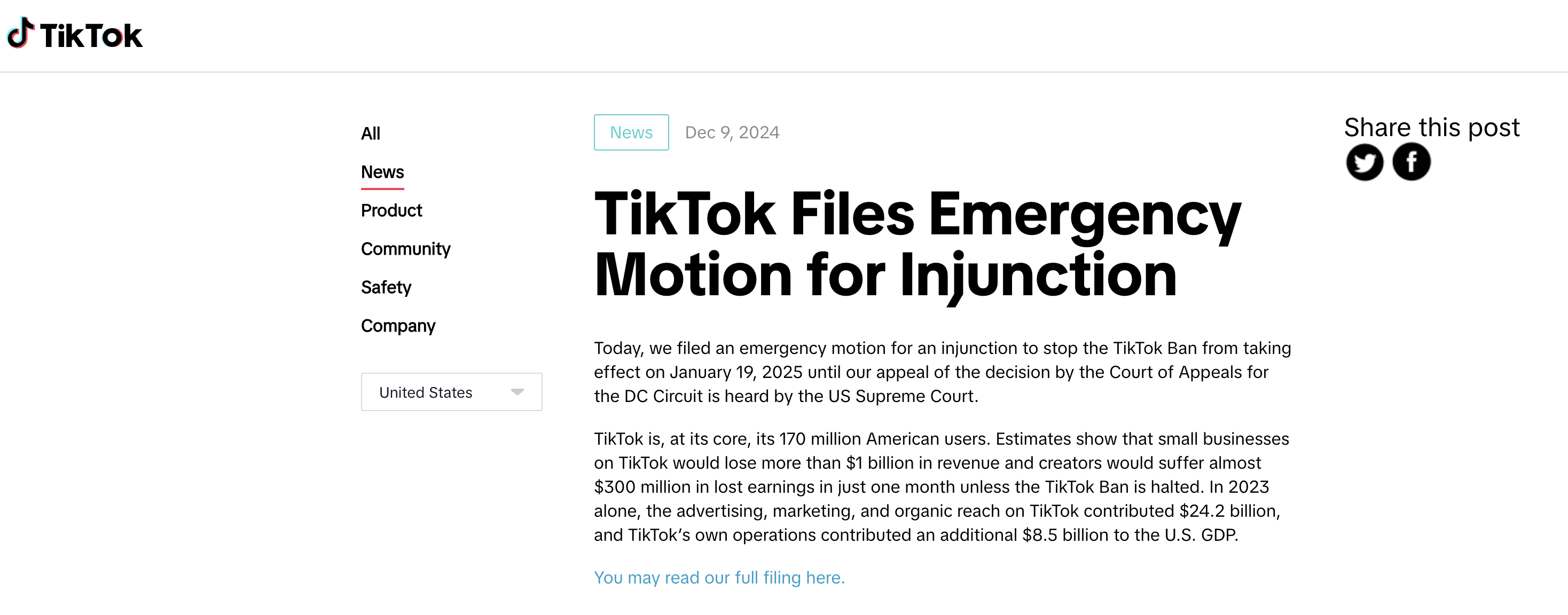Earlier this week, TikTok filed an emergency motion with the U.S. Supreme Court to block the ban. The company warned the ban could cost small businesses over $1 billion in revenue and creators nearly $300 million in just one month.

Source: TikTok
Former President Donald Trump, who previously vowed to protect TikTok, recently shared his thoughts:
"And I used TikTok, so I can’t really, you know, I can’t totally hate it. It was very effective. But I will say this, if you do do that, something else is going to come along and take its place. And maybe that’s not fair. And really, what the judge actually said was that you can’t have Chinese companies. In other words, they have the right to ban it if you can prove that Chinese companies own it. That’s what the judge actually said.”

Source: TikTok @NBC NEWS
As the situation unfolds, different opinions emerge from all sides.
1. TikTok’s Struggle to Save Itself
Before the ban, TikTok invested over $2 billion in a partnership with Oracle under "Project Texas." This initiative aimed to store U.S. user data on servers within Texas, addressing the government’s national security concerns.
However, U.S. officials deemed the effort insufficient, citing doubts about their ability to monitor the platform effectively. They suggested that separating TikTok from its Chinese parent company, ByteDance, would resolve these concerns.

Source: Pexels
Legal challenges haven’t helped either. In 2020, TikTok’s Fifth Amendment appeal, which protects against government overreach, failed. This year, the company cited the First Amendment, claiming the ban infringes on free speech.

Source: Pexels
The December 6 ruling, however, stated that the ban aligns with First Amendment values by limiting potential government control over U.S. social media platforms.
2. Opposition to the Ban
Many critics argue, “You can’t defend free speech by restricting it.”
“Orwellian Framework”
Tech blogger Mike Masnick described the court’s reasoning as “absurd and Orwellian.” He explained, “The First Amendment protects against government censorship and control of private speech. Using foreign influence as a justification undermines its core principles.”

Source: Pexels
“Unfair Targeting”
Others question why TikTok is being singled out. Media scholar Sarah Florini highlighted that Facebook’s 2021 whistleblower case revealed similar risks, such as algorithmic bias and data misuse.

Source: Pexels
Cybersecurity experts add that much of Americans’ personal data is already accessible through other means. Doug Jacobson, a cybersecurity researcher, stated, “If data surveillance is the concern, banning TikTok now is too late. Similar risks have existed with other social platforms for over a decade.”
“Preemptive Restrictions”
Some believe the government is using ownership changes to control speech. Critics argue that forcing ByteDance to divest TikTok amounts to “prior restraint”—preventing speech before it occurs, which contradicts First Amendment principles.
Masnick warned, “Banning TikTok restricts millions of Americans’ free speech and could set a dangerous precedent for further government interference in digital spaces.”

Source: Pexels
3. What’s Next for Users, Businesses, and Creators?
If the ban takes effect, TikTok will be removed from Apple and Google app stores. However, users may bypass this by downloading APK files or using third-party app stores.

Source: Pexels
Creators and small businesses reliant on TikTok for income are bracing for significant challenges. The platform has become a hub for influencer marketing and e-commerce. A 2024 report from Influencer Marketing Hub revealed that 70% of brands now use TikTok for marketing, with many shifting away from Instagram.
One TikTok influencer with 1.3 million followers said, “I don’t think this platform will last in the U.S. Please follow me on Instagram, YouTube, and other platforms.”
A travel blogger with nearly 900,000 followers added, “It took years to build this community. Now I need to redirect everything to Instagram.”

Source: Pexels
The ban could also impact TikTok Shop, a key tool for small businesses. Many brands have already shifted ad budgets from Meta to TikTok, relying on its unique appeal to younger audiences.
While TikTok’s legal motion to delay the ban is pending, the clock is ticking. With just six weeks left, users, businesses, and creators face an uncertain future.
Disclaimer: This article is compiled from the following sources and does not reflect the views or opinions of the author. All copyrights belong to the original creators.
「1」Reuters,ByteDance, TikTok seek temporary halt to US ban pending Supreme Court review,2024/12/10
「2」Fast Company,‘I need to know what’s going to be the new app’: TikTok influencers are pitching other platforms to their followers as a ban looms,2024/12/10
「3」The Verge,It sure sounds like Trump would be okay with a TikTok sale,2024/9/10
「4」Fast Company,How TikTok’s U.S. content creators are bracing for a possible ban in 6 weeks,2024/12/9
「5」Fast Company,TikTok ban: 5 essential reads on the case and its concerns,2024/12/7
「6」The Verge,TikTok failed to save itself with the First Amendment,2024/9/9
「7」The CONVERSATION,Facebook whistleblower Frances Haugen testified that the company’s algorithms are dangerous – here’s how they can manipulate you,2021/10/7